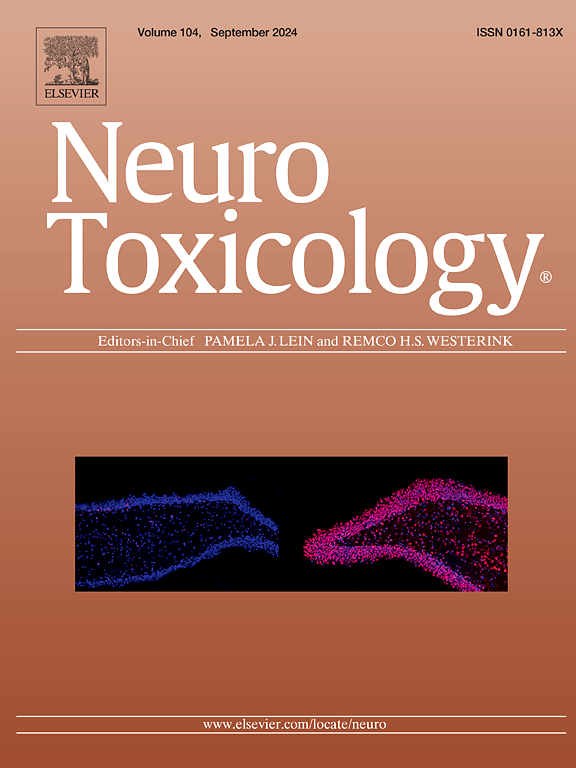1-Octen-3-ol exacerbates depression-induced neurotoxicity via the TLR4/NF-κB and Nrf2/HO-1 pathways
IF 3.9
3区 医学
Q2 NEUROSCIENCES
引用次数: 0
Abstract
1-Octen-3-ol is a volatile compound widely found in various fungi and plants, and studies have suggested its potential role in the development of neurodegenerative diseases. However, the mechanism by which 1-octen-3-ol induces neural injury in rats remains unclear. In this study, we used aerosolized 1-octen-3-ol to treat depressive model rats to investigate its effects on neural injury behaviors and neurophysiology in SD rats. The results showed that 1-octen-3-ol significantly increased the lung index to 0.47, reduced the sucrose preference rate to 42.9 %, decreased spontaneous exploration in the open field test, and increased immobility time in the forced swim test. Furthermore, 1-octen-3-ol disrupted blood-brain barrier permeability by reducing the expression of tight junction proteins Occludin and Claudin-1. It also promoted corticosterone secretion, reduced the release of monoamines (serotonin and norepinephrine) and amino acid neurotransmitters (5-hydroxytryptophan), and increased pro-inflammatory cytokines (TNF-α, IL-6, and IL-1β), leading to neuroendocrine damage. Additionally, it reduced the expression of synaptic proteins (PSD-95, Synapsin, and NMDA1) and neurotrophic factors (NT3 and NT4), resulting in impaired neuroplasticity. Simultaneously, 1-octen-3-ol activated the TLR4/NF-κB inflammatory pathway and suppressed the expression of the Nrf2/HO-1 antioxidant pathway, exacerbating neural injury in rats. These findings provide a mechanistic basis for the exacerbation of depression-induced neural injury by 1-octen-3-ol.
1-辛烯-3-醇通过TLR4/NF-κB和Nrf2/HO-1通路加重抑郁诱导的神经毒性
1-辛烯-3-醇是一种挥发性化合物,广泛存在于各种真菌和植物中,研究表明其在神经退行性疾病的发展中具有潜在作用。然而,1-辛烯-3-醇诱导大鼠神经损伤的机制尚不清楚。本研究采用1-辛烯-3-醇雾化治疗抑郁模型大鼠,探讨其对SD大鼠神经损伤行为和神经生理的影响。结果表明,1-辛烯-3-醇显著提高肺指数至0.47,降低蔗糖偏好率至42.9 %,减少了野外试验中的自发探索,增加了强迫游泳试验中的静止时间。此外,1-辛烯-3-醇通过降低紧密连接蛋白Occludin和Claudin-1的表达来破坏血脑屏障的通透性。它还促进皮质酮的分泌,减少单胺(血清素和去甲肾上腺素)和氨基酸神经递质(5-羟色氨酸)的释放,增加促炎细胞因子(TNF-α、IL-6和IL-1β),导致神经内分泌损伤。此外,它还降低了突触蛋白(PSD-95、Synapsin和NMDA1)和神经营养因子(NT3和NT4)的表达,导致神经可塑性受损。同时,1-辛烯-3-醇激活TLR4/NF-κB炎症通路,抑制Nrf2/HO-1抗氧化通路的表达,加重大鼠神经损伤。这些发现为1-辛烯-3-醇加重抑郁症引起的神经损伤提供了机制基础。
本文章由计算机程序翻译,如有差异,请以英文原文为准。
求助全文
约1分钟内获得全文
求助全文
来源期刊

Neurotoxicology
医学-毒理学
CiteScore
6.80
自引率
5.90%
发文量
161
审稿时长
70 days
期刊介绍:
NeuroToxicology specializes in publishing the best peer-reviewed original research papers dealing with the effects of toxic substances on the nervous system of humans and experimental animals of all ages. The Journal emphasizes papers dealing with the neurotoxic effects of environmentally significant chemical hazards, manufactured drugs and naturally occurring compounds.
 求助内容:
求助内容: 应助结果提醒方式:
应助结果提醒方式:


